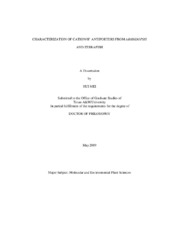| dc.contributor.advisor | Hirschi, Kendal | |
| dc.contributor.advisor | Gould, Jean | |
| dc.creator | Mei, Hui | |
| dc.date.accessioned | 2010-07-15T00:12:57Z | |
| dc.date.accessioned | 2010-07-23T21:44:20Z | |
| dc.date.available | 2010-07-15T00:12:57Z | |
| dc.date.available | 2010-07-23T21:44:20Z | |
| dc.date.created | 2009-05 | |
| dc.date.issued | 2010-07-14 | |
| dc.date.submitted | May 2009 | |
| dc.identifier.uri | https://hdl.handle.net/1969.1/ETD-TAMU-2009-05-599 | |
| dc.description.abstract | To maintain optimal cytosolic Ca2+ concentrations, cells employ three distinct
strategies: 1) tightly regulated influx of Ca2+; 2) efficient efflux of Ca2+ from the cell; 3)
sequestration of Ca2+ in organelles. Ca2+efflux and influx are mediated by diverse
transporter systems, such as pumps, channels and antiporters. Vacuolar localized
Ca2+/H+ exchangers such as Arabidopsis thaliana cation exchanger 1 (CAX1) play
important roles in Ca2+ homeostasis. When expressed in yeast, CAX1 is regulated via an
N-terminal autoinhibitory domain. I compared and contrasted the properties of Nterminal
CAX1 variants in plants and yeast expression systems to determine if
autoinhibition of CAX1 is occurring in planta. Although several plant transporters
appear to contain N-terminal autoinhibitory domains, my work is the first to document
clearly N-terminal-dependent regulation of a Ca2+ transporter in transgenic plants.
In my second study, I characterized another Arabidopsis CAX, CAX4. CAX4 is
expressed in the root apex and lateral root primordia and expression increased when Ni2+
or Mn2+ levels were elevated or Ca2+ was depleted. Transgenic plants expressing
increased levels of CAX4 displayed symptoms consistent with increased sequestration of
Ca2+ and Cd2+ into the vacuole. When CAX4 was highly expressed in an Arabidopsis cax1 mutant line with weak vacuolar Ca2+/H+ antiport activity, a 29% increase in
Ca2+/H+ antiport was measured. A cax4 loss-of-function mutant and CAX4 RNA
interference lines displayed altered root growth in response to Cd2+, Mn2+, and auxin.
The DR5::GUS auxin reporter detected reduced auxin responses in the cax4 lines. My
results indicate that CAX4 is a cation/H+ antiporter that plays an important function in
root growth under heavy metal stress conditions.
My third study is to characterize a zebrafish CAX. In this study, I have initiated
characterization of a zebrafish CAX by initially expressing the open reading frame in
yeast. Zebrafish Cax1 was localized on the yeast endomembranes and displayed Ca2+/H+
activity. In zebrafish embryos, Cax1 was specifically expressed in neural crest cells and
morpholino knockdowns of cax1 caused defects in neural crest development as
measured by alterations in pigmentation, defects in jaw development and reduction in
expression of the neural crest marker, pax7. Collectively, our findings provide a
previously unexpected role of CAX transporters in animal growth and development. | en |
| dc.format.mimetype | application/pdf | |
| dc.language.iso | eng | |
| dc.subject | CAXs, N-terminal qutoinhibition, root development, Type II CAXs, zebrafish, Arabidopsis | en |
| dc.title | Characterizations of Cation/H+ Antiporters from Arabidopsis and Zebrafish | en |
| dc.type | Book | en |
| dc.type | Thesis | en |
| thesis.degree.department | Ecosystem Science and Management | en |
| thesis.degree.discipline | Molecular and Environmental Plant Sciences | en |
| thesis.degree.grantor | Texas A&M University | en |
| thesis.degree.name | Doctor of Philosophy | en |
| thesis.degree.level | Doctoral | en |
| dc.contributor.committeeMember | Loopstra, Carol | |
| dc.contributor.committeeMember | lineberger, Daniel | |
| dc.type.genre | Electronic Dissertation | en |
| dc.type.material | text | en |


